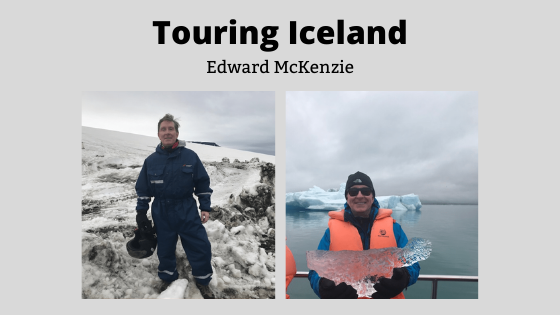In recent years Iceland has become something of a “must-visit” location for adventurers, and after a 2019 visit there with my college-age son, Scott, I am convinced that those seeking to see some of the world’s true natural wonders must put it on their list. In our one week visit we saw a remarkable variety of natural features that adjectives to describe the sites are insufficient. Further, the activities that we enjoyed while there were simultaneously fun, interesting, challenging, and educational.
Sitting on the point at which the Eurasian tectonic plate meets the North American plate, Iceland was created out of volcanic eruptions emanating from the juncture of the two plates. As a consequence, the landscape maintains the rough images of volcanic formation, over which moss gradually grew, and eventually, in coastal areas, soil. Due to limited suitable farmland and harsh weather, few crops or livestock are cultivated on the island nation. But it is that harsh weather, coupled with the volcanic landscape that gives the sites an ethereal feel.
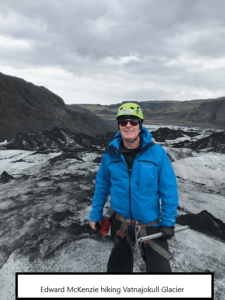 Glaciers, waterfalls, icebergs and geysers abound. Thermal pools are the recreational retreat of locals and visitors alike. Fresh fish is the culinary treat. And the national personal disposition of locals is shy yet welcoming.
Glaciers, waterfalls, icebergs and geysers abound. Thermal pools are the recreational retreat of locals and visitors alike. Fresh fish is the culinary treat. And the national personal disposition of locals is shy yet welcoming.
Permit me to offer details of our visit.
Along the country’s south coast, at Jokulsarlon Glacier Lagoon, we sailed through a wonderland of massive white and electric blue icebergs. The bergs break off from Jokulsarlon Glacier, an inland glacier, and float into the lagoon and ultimately out to sea. The startling, yet quietly peaceful scene of the stark glaciers is visually shocking, as are so many scenes in this country of natural wonders. Further startling to the eyes is the black beach where the icebergs exiting the lagoon break into smaller pieces and scatter all over the beach and shoreline. When the sunlight hits the scattered icebergs, they resemble chunks of diamonds, earning the beach the nickname “Diamond Beach.”
But throughout the trip along the south of the island visitors see dozens of waterfalls, both large and small. The water emanates from the Mydalsjokull and Eyjafjallajokull glaciers in the highland plateau in the center of the country. With increased global warming, the glaciers are melting at an alarming rate, producing new streams and rivers that turn into wonderful waterfalls as they fall from the high plateau to the lower coastal lands.
Traveling along the south coast we passed the stunning waterfalls of Seljalandsfoss and Skogafoss which are similar in height but vastly different. The former is light and teasing, with an open grotto behind the cascading water, into which we were able to walk for a unique point of view form behind the 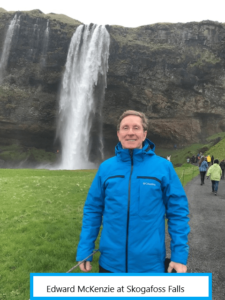 waterfall. The other waterfall, Skogafoss, is a plunging wall of water, powerful and absolutely stunning.
waterfall. The other waterfall, Skogafoss, is a plunging wall of water, powerful and absolutely stunning.
Our guide’s van dropped us off in a parking lot from which we hiked approximately 1.5 miles to get to Vatnajokull Glacier. The guide explained that when the parking lot was built in 2010, the glacier was located next to the parking lot. However, in the 10 years since the parking lot was built, the glacier has receded 1.5 miles. Honestly, it was sad and shocking to contemplate this change in thousands of years of nature.
We were issued hiking gear and climbed up the glacier and saw streams of water coming off the glacier were alarming. Nonetheless, the glacier itself, having been formed over centuries, was an impressive mountain and difficult to climb. Fortunately the foot grips and pick-axes that we were supplied made it safe and enjoyable. But, moreover, again the visual scenery was impressive. Tall mountains of white, with hints of blue, and shaded by streams of water cascading off the white mountains, was something everyone should see. Sadly, I must counsel potential visitors to go soon as the rate of melting to the glaciers leads one to suspect that they will not be there long.
The most historically significant site in Iceland is Thingvellir National Park, the site of the founding of the Icelandic Parliament in 930AD by the Vikings. A little known fact is that this democracy, founded more than 1000 years ago, is the longest ongoing democracy and representative parliament in the world. In what is now this national park, not only did parliament meet until 1798 (when it moved to Reykjavik, the current capital) but many witch trials were held at this site, along with numerous battles and duels. It was in this site that Iceland declared its conversion to Christianity, its independence from Denmark, and in which it elected it first President.
More importantly, this Park is the site where the Eurasian and North American continents meet in what is known as the North Atlantic Dorsal Rift—in essence, a valley between the two continents.
Nearby lies the Great Geysir, a word famous hot spring in Haukadalur Valley. “Geysir” is one of only two Icelandic words to be adopted into English. The Great Geysir sometimes goes for years without an eruption and at other times shoots as high as 230 feet in the air.
Another geyser in the area, Strokkur, erupts every 10 minutes shooting up to 130 feet.
The geysers are caused by fumaroles, or a vent for steam and hot gases from the earth’s crust.
Besides the geysers, nearby is Gullfoss, one of the most beautiful and beloved waterfalls in Iceland. 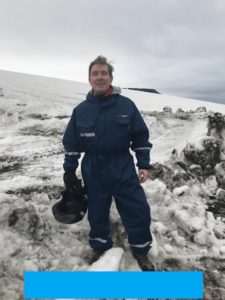 This mighty waterfall cascades 104 feet in two separate falls, in a dramatic gorge formed in the last Ice Age. Platforms near the river allow visitors to stand close enough to feel the water spray on their faces. The sunshine hitting the spray throws off beautiful rainbows, thus earning the waterfall the name that translates to “the Golden waterfall.”
This mighty waterfall cascades 104 feet in two separate falls, in a dramatic gorge formed in the last Ice Age. Platforms near the river allow visitors to stand close enough to feel the water spray on their faces. The sunshine hitting the spray throws off beautiful rainbows, thus earning the waterfall the name that translates to “the Golden waterfall.”
A fun activity that Scott and I enjoyed was glacier snowmobiling on the Langjokull Glacier in the Golden Circle. We were provided with cold weather closing, gloves, helmets and boots for this adventure. The absolute white landscape, as far as the eye can see, blend with the white sky to make the glacier seem infinite. We rode along at speed of up to 60 m.p.h., hitting bumps and going over ridges in nature. It was a lot of fun and Scott was especially good at snowmobiling. (Not bad for an island boy!)
On the northwest side of Iceland is Snaelfellsnes Peninsula, the site of numerous natural features. Most notably, we visited the charming villages of Arnarsapi and Hellnar. These small fishing towns are steeped in history and folklore, and the surrounding coastal area is filled with amazing cliffs and beautiful rock formations.
Notably, we learned that in the 6 months of warmer weather when fishermen can venture out to sea, these villages account for 1% of all the world’s fish harvest! What is more, the fishermen are so wealthy from their trade, that they typically have villas in the Mediterranean where they spend their winters.
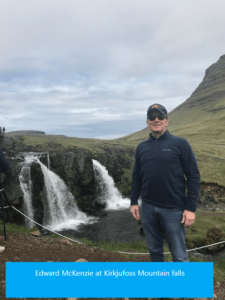 Ultimately on the peninsula we visited Kirkjufell mountain. This arrow shaped mountain, with two waterfalls in its foreground, is among the most photographed sites in Iceland. The mountain rises boldly from the ground, with rolling hills, crystalline rivers and tumbling falls to its south, and the ocean spreading around its other sides. The mountain is visible from all sides a s a lovely mountain trail surrounds it.
Ultimately on the peninsula we visited Kirkjufell mountain. This arrow shaped mountain, with two waterfalls in its foreground, is among the most photographed sites in Iceland. The mountain rises boldly from the ground, with rolling hills, crystalline rivers and tumbling falls to its south, and the ocean spreading around its other sides. The mountain is visible from all sides a s a lovely mountain trail surrounds it.
But with all this discussion of nature, which is by far the most compelling reason to visit Iceland, I have failed to mention the capital city of Reykjvik. As the world’s northern-most capital city, Reykjavik combines small town charm and big city living. With a population of 150,000, its streets are known to be clean, peaceful, and more than anything, safe. For those seeking culture, the city has a beautifully-designed concert hall (“Harpa”), as well as many galleries and museums.
Reykajavik is renowned for its cuisine, with food from all around the world. Indeed, Scott and I enjoyed traditional Spanish food as well as great Japanese food. But visitors must try the local fish and lamb. In fact, the best salmon I have ever eaten I enjoyed in a Reykjavik restaurant. Further, I was surprised at how much I enjoyed the local lamb. Truly delicious.
Scott was able to find a wonderful public bath that has several large pools heated with natural hydrothermal waters. As darkness doesn’t descend until after 10:30pm (in May), we found lots of people lounging in the public baths well into the evening. In fact, each day after our days of hiking, snowmobiling and engaging in other activities, Scott and I went to the public bath with some beer or wine in hand, and enjoyed the waters that were kept between 98F and 110F. It was a great relaxation, and a nice way to meet locals up close.
So, I hope I have whet your appetite for a visit to this startling country to the north!
